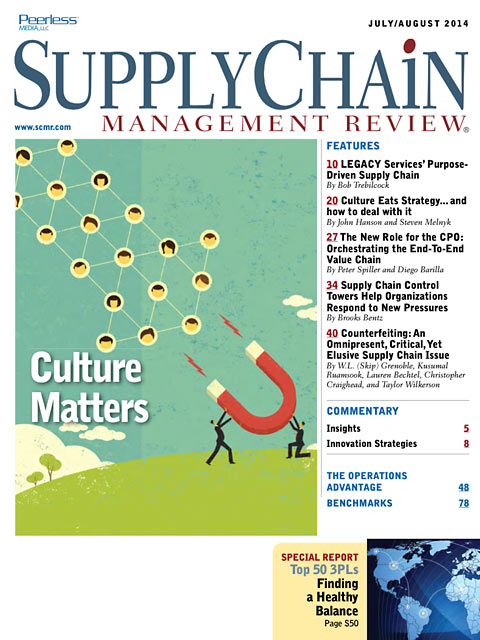Sorry, but your login has failed. Please recheck your login information and resubmit. If your subscription has expired, renew here.
July-August 2014
LEGACY Supply Chain Services has made company culture the centerpiece of how it drives innovation, efficiency, and the creation of value for its customers. Is it a model that others should replicate? Browse this issue archive.Need Help? Contact customer service 847-559-7581 More options
Anyone who has ever been offered a $40 Rolex or a $25 Gucci handbag understands that counterfeit goods are as accessible as hot dog vendors on the streets of any big American city. The problem is so prevalent that there’s even a word for it: Fucci, which means fake Gucci.
Counterfeiting activities are no longer limited to easy-to-produce luxury branded consumer goods. Over the last few years, they have evolved from localized activities to a global phenomenon that requires cross-national countermeasures on an industrial scale, at times with dire consequences. Aside from economic detriment, consumer safety is also at risk as counterfeiting activities are encroaching across a wider range of safety-critical products such as pharmaceuticals, electronic components, medical devices, and automotive and aircraft parts that are critical to their safe operation. Recently, The Wall Street Journal reported on the largest confiscation of counterfeit medicines in history when customs officials in Luanda, Angola, uncovered 1.4 million packets of counterfeit Coartem, a drug used to treat malaria. Just two years ago, the New York Times reported that at least 20 people were killed and dozens of others were seriously injured in the Czech Republic from consuming bootleg rum, vodka, and other spirits they purchased on the cheap at street kiosks. Laced with methanol to make the product stretch farther, the bottles bore fake labels from Czech liquor makers to fool the public.
Counterfeiting is not limited to Eastern Europe and emerging markets. In the United States, a recent report on counterfeit seizures released by U.S. Customs and Border Protection (CBP) indicates that critical technology components, electronic articles, batteries, and transportation parts now join the rank of top ten categories of counterfeit and piracy products seized by CBP in 2011.
 |
This complete article is available to subscribers
only. Click on Log In Now at the top of this article for full access. Or, Start your PLUS+ subscription for instant access. |
Not ready to subscribe, but need this article?
Buy the complete article now. Only $20.00. Instant PDF Download.
Access the complete issue of Supply Chain Management Review magazine featuring
this article including every word, chart and table exactly as it appeared in the magazine.
SC
MR
Sorry, but your login has failed. Please recheck your login information and resubmit. If your subscription has expired, renew here.
July-August 2014
LEGACY Supply Chain Services has made company culture the centerpiece of how it drives innovation, efficiency, and the creation of value for its customers. Is it a model that others should replicate? Browse this issue archive. Access your online digital edition. Download a PDF file of the July-August 2014 issue.
 |
Download Article PDF |
Anyone who has ever been offered a $40 Rolex or a $25 Gucci handbag understands that counterfeit goods are as accessible as hot dog vendors on the streets of any big American city. The problem is so prevalent that there’s even a word for it: Fucci, which means fake Gucci.
Counterfeiting activities are no longer limited to easy-to-produce luxury branded consumer goods. Over the last few years, they have evolved from localized activities to a global phenomenon that requires cross-national countermeasures on an industrial scale, at times with dire consequences. Aside from economic detriment, consumer safety is also at risk as counterfeiting activities are encroaching across a wider range of safety-critical products such as pharmaceuticals, electronic components, medical devices, and automotive and aircraft parts that are critical to their safe operation. Recently, The Wall Street Journal reported on the largest confiscation of counterfeit medicines in history when customs officials in Luanda, Angola, uncovered 1.4 million packets of counterfeit Coartem, a drug used to treat malaria. Just two years ago, the New York Times reported that at least 20 people were killed and dozens of others were seriously injured in the Czech Republic from consuming bootleg rum, vodka, and other spirits they purchased on the cheap at street kiosks. Laced with methanol to make the product stretch farther, the bottles bore fake labels from Czech liquor makers to fool the public.
Counterfeiting is not limited to Eastern Europe and emerging markets. In the United States, a recent report on counterfeit seizures released by U.S. Customs and Border Protection (CBP) indicates that critical technology components, electronic articles, batteries, and transportation parts now join the rank of top ten categories of counterfeit and piracy products seized by CBP in 2011.
 |
SUBSCRIBERS: Click here to download PDF of the full article. |
SC
MR

Latest Supply Chain News
Latest Podcast

 Explore
Explore
Topics
Latest Supply Chain News
- Strengthening customer fulfillment: Building a strategic stakeholder network
- The hard job of teaching soft skills
- Trump picks former Wisconsin congressman Sean Duffy for DOT secretary
- Made in Mexico, manufactured by China
- Retail sales see gains in October, reports Commerce and NRF
- Balancing green and speed: Home delivery insights from the pandemic era
- More latest news
Latest Resources

Subscribe

Supply Chain Management Review delivers the best industry content.

Editors’ Picks





